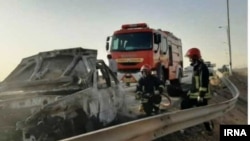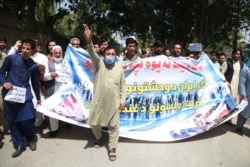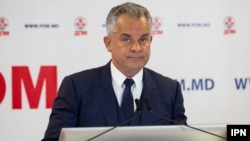
As a corpse sticks out from the back of a blazing car on a road in central Iran, a badly burned young Afghan who escaped the flames stumbles along the road.
"Give me some water, I'm burning!" the migrant screams in pain.
The harrowing minute-long video, which went viral on social media, shows a gruesome scene in which Iranian police are purported to have shot a car carrying Afghan migrants, causing it to explode in flames.
Three passengers were killed while five others were hospitalized with burns. A video showed at least one of the injured handcuffed to a hospital bed.
The grisly incident in Yazd Province on June 5 has caused outrage in Afghanistan and rekindled a long-running debate about the treatment of Iran's sizable Afghan community.
It comes just a month after Afghan officials said Iranian border guards killed 45 Afghan migrant workers by forcing them at gunpoint into a river along the two countries' 900-kilometer frontier.
The two events have sent Afghans protesting in the streets and onto social media to denounce Iranian authorities for what they allege is abuse and discrimination against the estimated 1 million Afghan migrants and refugees in neighboring Iran.
Hold 'Perpetrators Accountable'
Afghan President Ashraf Ghani on June 8 called for a thorough investigation of the incident.
The Foreign Ministry said the same day that "no legal channel will be spared to legally hold the perpetrators accountable."
The ministry said authorities in Yazd have admitted that their police shot the vehicle carrying the Afghan migrants. The ministry also said the video uploaded on social media was genuine.
Yazd Deputy Governor Ahmad Tarahomi told Iranian state media that police fired on the vehicle, which they suspected was carrying drugs and undocumented migrants, after it crashed through a checkpoint.
Tarahomi said, that after its wheels were hit, the car continued to drive on its wheel rims, causing sparks that ignited the fire.
Since the incident, angry Afghans have staged rallies across Afghanistan, with demonstrators condemning Iranian authorities and demanding action from their government.
The largest rallies were held in the capital, Kabul, the eastern province of Nangarhar, and the western province of Herat, where scores demonstrated outside the Iranian Consulate on June 10.
'I Am Burning!'
Using the hashtags #StopKillingAfghans and #Iamburning, Afghans have been all over social media with the message: Afghan Lives Matter.
The campaign was inspired by the Black Lives Matter movement begun in the United States and the international outcry over the killing of George Floyd, an African-American who died at the hands of police in the U.S. state of Minnesota on May 25. His death has fueled rallies around the world for minority rights.
"A boy screams for a drop of water, but no one gives him [any]. He is burnt. Where is [the] humanity?" tweeted Javid Ahmad Qaem, Afghanistan's ambassador to China, on June 6.
Timor Sharan, a former deputy minister, said on June 5 that "words cannot describe the barbarism and inhumanity of this act by Iran security forces."
Shaharzad Akbar, the head of Afghanistan's Independent Human Rights Commission, said the incident in Yazd must be investigated.
"[The] perpetuators need to be held accountable," she tweeted on June 6. "Human lives matter. Refugee rights are human rights."
An online petition, aimed at the United Nations as well as the Iranian and Afghan governments, had received more than 53,000 signatures as of June 11.
History Of Discrimination
International human rights groups have long documented violations against Afghan refugees and migrants in Iran, including physical abuse, detention in unsanitary and inhumane conditions, forced payment for transportation and accommodation in camps, slave labor, and the separation of families.
In May, dozens of Afghans illegally crossed into Iran and were detained by Iranian border guards, who allegedly beat, tortured, and then forced them to jump into the Harirud, a 1,100 kilometer-long river shared by Afghanistan, Iran, and Turkmenistan. Many of them drowned.
Iran denied the incident took place on Iranian soil. But Afghan and Iranian authorities launched a joint investigation, the results of which have not yet been released.
And in December 2018, a viral video appeared to show an Iranian police officer slapping, insulting, and humiliating a group of Afghan migrants.
The UN estimates the number of Afghan citizens in Iran at just under 1 million. Tehran puts the figure of documented and undocumented Afghan refugees and migrants closer to 3 million.
For decades, Afghans weary of war and poverty have turned to Iran to earn a living. Tehran has expelled many Afghans -- who are often blamed for insecurity and unemployment -- and periodically threatens those who remain with mass expulsion.
Many other Afghans moved to Iran following the decade-long Soviet occupation of Afghanistan and the long civil war that followed the Soviet withdrawal.
Others sought refuge in Iran after the fundamentalist Taliban took power in Afghanistan. After the U.S.-led invasion that followed the 9/11 terrorist attacks in 2001, some Afghans left for Iran in search of jobs, although hundreds of thousands of them returned last year amid a crippling economic crisis in the country.
Thus far in 2020, it is estimated that more than 310,000 Afghans living in Iran have returned home, according to the International Organization for Migration (IOM). Some have returned due to the coronavirus pandemic, which has hit Iran particularly hard, and the worsening economic situation there. Many Afghans take on menial work that many Iranians are not interested in.
In 2015, Iranian Supreme Leader Ayatollah Ali Khamenei issued a decree allowing all Afghan children to go to school. But Afghans are still denied basic services, including access to health care, jobs, and housing.










